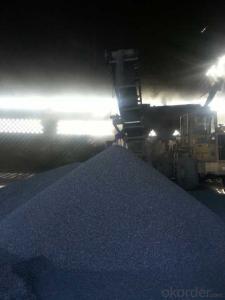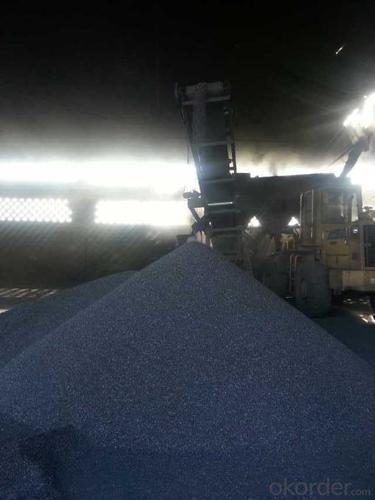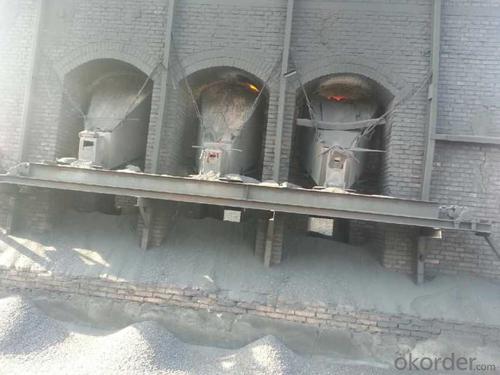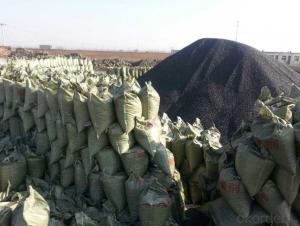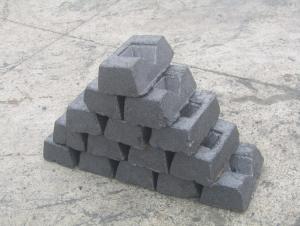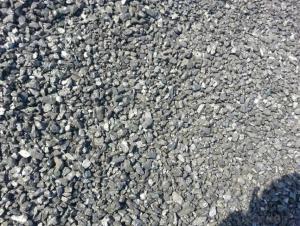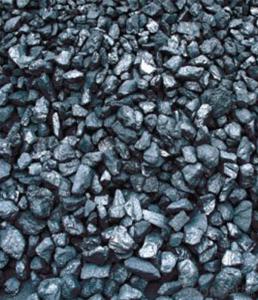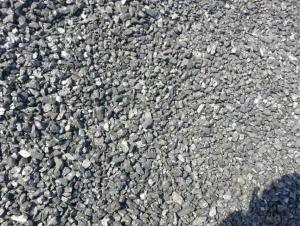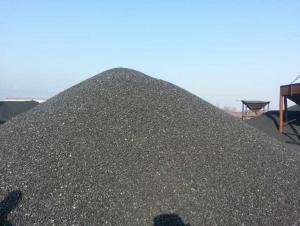Injection carbon FC93 with high and stable quality
- Loading Port:
- Tianjin
- Payment Terms:
- TT OR LC
- Min Order Qty:
- 20 m.t.
- Supply Capability:
- 3000 m.t./month
OKorder Service Pledge
OKorder Financial Service
You Might Also Like
Packaging & Delivery
25kgs/50kgs/1ton per bag or as buyer's request
Specifications
Calcined Anthracite
Fixed carbon: 90%-95%
S: 0.5% max
Size: 0-3. 3-5.3-15 or as request
It used the high quality anthracite as raw materials through high temperature calcined at over 2000 by the DC electric calciner with results in eliminating the moisture and volatile matter from anthracite efficiently, improving the density and the electric conductivity and strengthening the mechanical strength and anti-oxidation. It has good characteristics with low ash, low resistvity, low sulphur, high carbon and high density. It is the best material for high quality carbon products.
Advantage and competitive of caclined anthracite:
1. strong supply capability
2. fast transportation
3. lower and reasonable price for your reference
4.low sulphur, low ash
5.fixed carbon:95% -90%
6..sulphur:lower than 0.3%
General Specification of Calcined Anthracite:
| FC | 95 | 94 | 93 | 92 | 90 |
| ASH | 4 | 5 | 6 | 6.5 | 8.5 |
| V.M. | 1 | 1 | 1 | 1.5 | 1.5 |
| S | 0.3 | 0.3 | 0.3 | 0.35 | 0.35 |
| MOISTURE | 0.5 | 0.5 | 0.5 | 0.5 | 0.5 |
Pictures
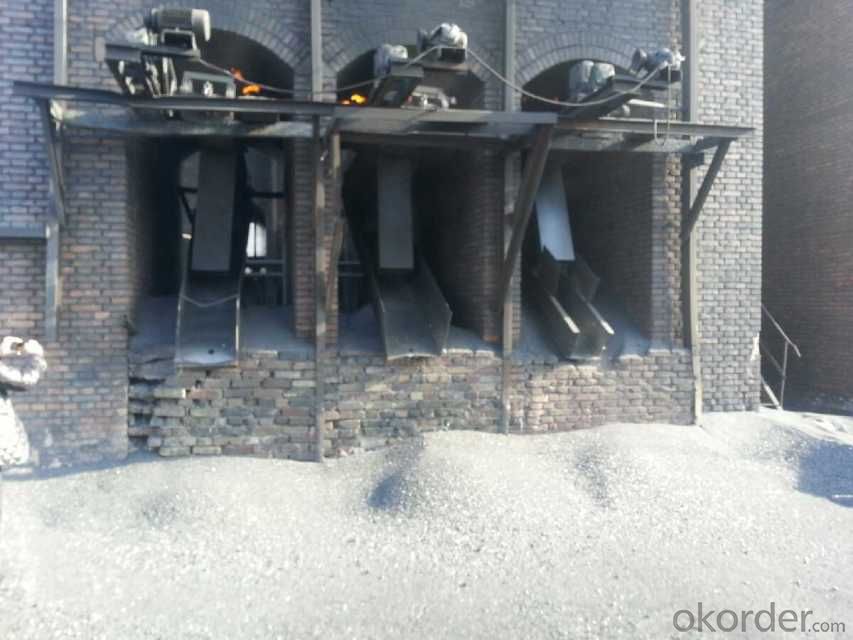
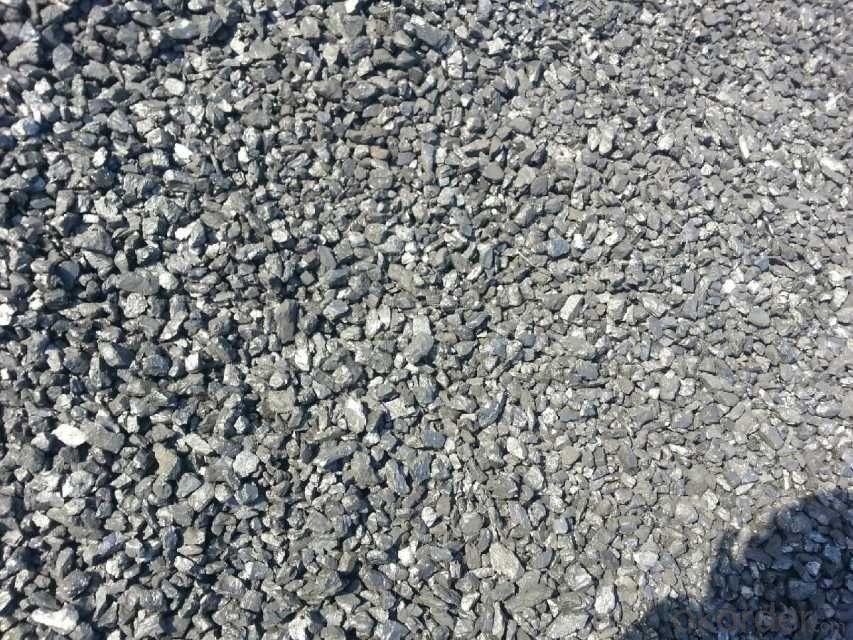
- Q: How does carbon contribute to the structure of DNA?
- Carbon is an essential element in the structure of DNA as it forms the backbone of the molecule. Carbon atoms in the sugar-phosphate backbone of DNA provide stability and flexibility, allowing the molecule to twist and fold into its double helix shape. Additionally, carbon atoms are also present in the nitrogenous bases, which are the building blocks of the genetic code. Overall, carbon's presence in DNA is crucial for its overall structure and function in storing and transmitting genetic information.
- Q: What are the advantages and disadvantages of carbon monoxide and carbon dioxide?
- Carbon monoxide is a common poison, but trace use is good for organ transplants. British researchers have recently developed a new method that can effectively use carbon monoxide to help transplant organs survive, while avoiding the risk of carbon monoxide poisoning. Excessive inhalation of carbon monoxide poisoning will lead to death, carbon monoxide into the human body, and soon the hemoglobin in blood combined with the formation of carboxyhemoglobin, causes red blood cells to reduce the oxygen carrying, the tissue hypoxia in vivo. The cardiac and central biblical system is the most sensitive to hypoxia and the earliest affected. In the air of carbon monoxide concentration reached 117 mg / M 3, people can feel headache, vertigo: up to 292.5 mg / M 3 symptoms; up to 582.5 mg / M 3 will be nausea and vomiting, exhaustion, if not timely rescue can have life risk. When the concentration of carbon monoxide in the air reaches 11700 mg / M 3, a coma occurs; the concentration of carbon monoxide in the air reaches 1170 mg / m. The 3 spoons will soon die. This is bad. But in organ transplant operations, the use of trace amounts of carbon monoxide helps dilate blood vessels and reduce inflammation, thereby increasing the survival rate of transplanted organs.
- Q: What is carbon steel, carbon manganese steel?
- Compared with other kinds of steel, carbon steel is the earliest, low cost, wide performance range and the largest amount. For nominal pressure PN is less than or equal to 32.0MPa, temperature of -30-425 water, steam, air, hydrogen, ammonia, nitrogen and petroleum products such as medium. Commonly used grades are WC1, WCB, ZG25 and high quality steel 20, 25, 30 and low-alloy structural steel 16Mn
- Q: Why carbon fiber resistant to low temperature
- Resistance to 180 DEG C carbon fiber can be low temperature, under this condition, many materials are brittle, even sturdy steel has become fragile than glass, and carbon fiber under this condition is still very soft.
- Q: What are the effects of carbon emissions on the stability of peatlands?
- Carbon emissions have significant effects on the stability of peatlands. Increased levels of carbon dioxide in the atmosphere contribute to global warming, which in turn accelerates the decomposition of organic matter in peatlands. This decomposition releases even more carbon dioxide, creating a positive feedback loop that further exacerbates climate change. Additionally, rising temperatures and changing precipitation patterns can lead to the drying out of peatlands, making them more prone to wildfires. These fires release massive amounts of carbon dioxide into the atmosphere, further contributing to climate change. Overall, carbon emissions threaten the stability of peatlands by accelerating their degradation and releasing large amounts of greenhouse gases.
- Q: Which carbon content is larger, steel or pig iron?
- carbon content more than 2.11% of iron, iron carbon content in general industry 2.5%--4%. I hope I can help you.
- Q: How does carbon impact the melting of polar ice caps?
- The primary way in which carbon affects the melting of polar ice caps is through climate change. Carbon dioxide, a greenhouse gas, traps heat in the atmosphere and causes the Earth's temperature to rise. This rise in temperature leads to the melting of polar ice caps. Human activities, such as burning fossil fuels, deforestation, and industrial processes, release carbon into the atmosphere. This carbon accumulates and contributes to the greenhouse effect. As the concentration of carbon dioxide increases, more heat is trapped, resulting in global warming. The warming caused by carbon has a particularly detrimental effect on polar ice caps, especially those in the Arctic and Antarctica. Rising temperatures accelerate the melting of the ice caps, causing them to shrink and eventually collapse. This process is known as ice cap retreat. The impact of carbon on polar ice caps is two-fold. Firstly, the melting of ice caps contributes to rising sea levels, which poses a significant threat to coastal communities and low-lying areas worldwide. As the ice caps melt, the water flows into the oceans, causing them to expand. This can result in coastal erosion, increased flooding, and the loss of valuable habitats and ecosystems. Secondly, the melting of polar ice caps also disrupts the delicate balance of the Earth's climate system. The reflective surface of ice helps regulate the planet's temperature by reflecting sunlight back into space. However, as the ice melts, it is replaced by darker surfaces that absorb more heat, such as water or land. This further intensifies global warming, creating a feedback loop that accelerates the melting process. Overall, the impact of carbon on the melting of polar ice caps is significant. The continuous release of carbon into the atmosphere contributes to the loss of these crucial ecosystems, leads to sea-level rise, and disrupts the Earth's climate system. To mitigate these effects, it is crucial to reduce carbon emissions and transition to cleaner and more sustainable sources of energy.
- Q: How does carbon dioxide affect the formation of clouds?
- Cloud formation is significantly influenced by carbon dioxide in Earth's climate system. This is because carbon dioxide acts as a greenhouse gas, trapping heat in the atmosphere and causing a global increase in temperatures. This rise in temperature affects various atmospheric processes, including the formation of clouds. One of the main ways carbon dioxide impacts cloud formation is by affecting the water cycle. Increased levels of carbon dioxide lead to warmer temperatures, which result in more water evaporating from the Earth's surface. This increased evaporation leads to a higher amount of water vapor in the atmosphere, which is essential for the formation of clouds. In addition, carbon dioxide indirectly influences cloud formation by influencing atmospheric stability and the vertical movement of air. Higher concentrations of carbon dioxide can change the temperature profile of the atmosphere, causing the lower atmosphere to warm more than the upper atmosphere. This temperature difference can alter air density, causing air to rise or sink. Rising air promotes cloud formation, while sinking air inhibits it. Moreover, carbon dioxide affects the size and properties of cloud droplets. Increased concentrations of carbon dioxide can result in changes in the microphysical properties of clouds, such as smaller droplet size and concentration. Research suggests that higher carbon dioxide levels may impact cloud lifetime and precipitation patterns. It is important to note that the relationship between carbon dioxide and cloud formation is complex and remains an active area of research. Scientists are continuously studying the intricate interactions between atmospheric gases, cloud formation, and climate change to gain a better understanding of the future implications of carbon dioxide emissions on cloud dynamics and the overall climate system.
- Q: The main difference between steel and iron is the difference in carbon content
- Steel carbon content is 0.03% ~ 2% of the iron carbon alloy. Carbon steel is the most commonly used ordinary steel smelting, convenient, easy processing, low price, and can satisfy the use requirement in most cases, it is widely used. According to the different carbon content, carbon steel is divided into low carbon steel, medium carbon steel and high carbon steel with the carbon content increased, decreased the hardness, toughness of carbon steel alloy steel. Also called special steel, adding one or more alloying elements in steel on the basis of the change of microstructure and properties of steel, it has some special properties, such as high hardness, high wear resistance, high toughness and corrosion resistance sex, etc.
- Q: How does carbon affect the color of gemstones?
- Carbon can affect the color of gemstones by either enhancing or modifying their natural hues. When present as impurities or inclusions, carbon can give gemstones a yellow or brown color. However, when arranged in a specific crystal lattice, carbon can create exceptional colorless or white gemstones, such as diamonds.
Send your message to us
Injection carbon FC93 with high and stable quality
- Loading Port:
- Tianjin
- Payment Terms:
- TT OR LC
- Min Order Qty:
- 20 m.t.
- Supply Capability:
- 3000 m.t./month
OKorder Service Pledge
OKorder Financial Service
Similar products
Hot products
Hot Searches
